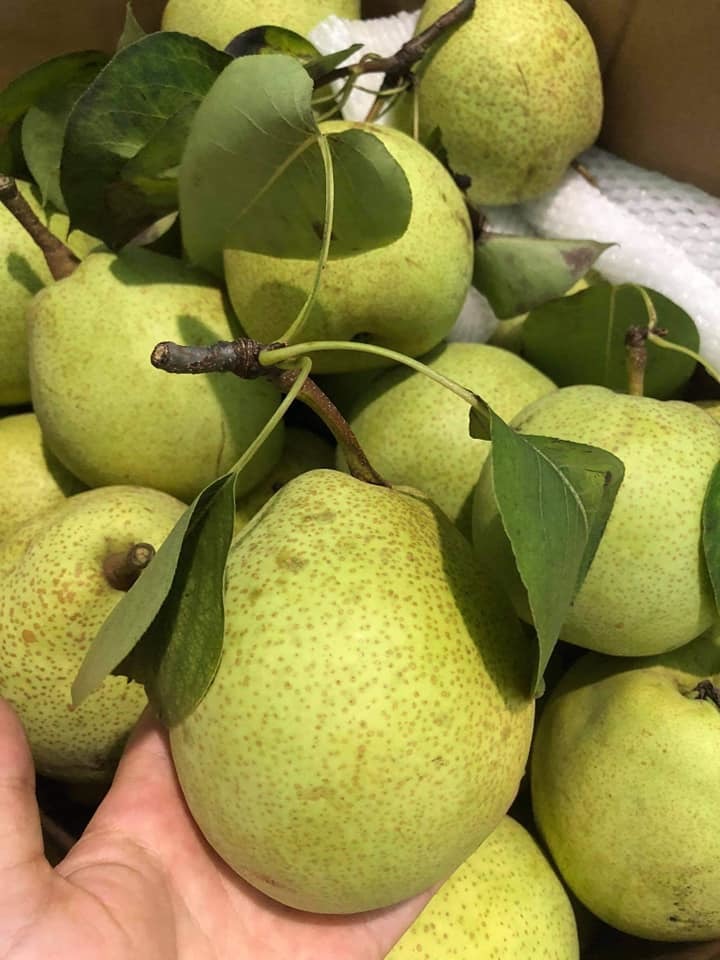
Pears are not only a delicious and nutritious fruit but also an agricultural product with significant export potential for Vietnam. With favorable climate and soil conditions, many regions across the country have been developing pear cultivation, bringing high economic efficiency to farmers.
1. Origin and Growing Regions
Pears are widely grown in many northern mountainous provinces of Vietnam, where the temperate and subtropical climates are cool and particularly suitable for pear tree development. Key pear growing regions include:
- Lang Son: Famous for its “tai nung” and yellow pear varieties, widely planted in Bac Son, Binh Gia, and Trang Dinh districts. Lang Son pears have thin skin, thick flesh, and a sweet, crisp taste.
- Cao Bang: Pear varieties like Dong Khe and Thach An pears are favored for their distinctive flavor and good quality.
- Ha Giang: Pears are grown in Dong Van and Meo Vac, especially the “da” (stone) pear variety, known for its crispness and intense sweetness.
- Son La: Local and some imported pear varieties are also being developed here.

2. Nutritional Value
Pears are rich in nutrients and offer many health benefits. In 100g of fresh pear, there are:
- Energy: Approximately 57 kcal
- Carbohydrates: About 15g, mainly fructose, glucose, and sucrose.
- Fiber: Around 3g, which aids digestion and prevents constipation.
- Vitamin C: Approximately 4.3mg, a powerful antioxidant that boosts the immune system.
- Vitamin K: About 4.5 µg, important for blood clotting and bone health.
- Copper: Approximately 0.08 mg, essential for many enzyme functions in the body.
- Potassium: About 116 mg, helps maintain stable blood pressure.
- Additionally, pears contain small amounts of B vitamins (B1, B2, B3, B6), iron, magnesium, manganese, and antioxidants like flavonoids and anthocyanins.
3. Export Products from Pears
Besides exporting fresh pears, Vietnam can also diversify processed pear products to increase value and expand markets:
- Fresh Pears: This is the main export product, requiring high quality in appearance, freshness, and food safety.
- Dried Pears: Soft or crispy dried pears are convenient, easy-to-preserve products, suitable as snacks or ingredients in confectionery.
- Pear Juice: Pure pear juice or combined with other fruits is a nutritious beverage.
- Pear Jam, Pear Syrup: Deeply processed products can be used in cuisine or as gifts.
- Pear Wine: Some regions can develop pear wine, creating a characteristic local product.
4. Export Markets
Currently, Vietnamese pears are mainly consumed domestically. However, export potential is gradually being exploited. Potential markets for Vietnamese pears include:
- China: A large and close market with high demand for imported fruits. However, quality and quarantine requirements are becoming increasingly stringent.
- ASEAN Countries: Thailand, Laos, and Cambodia are neighboring markets that are easy to access.
- South Korea, Japan: These are demanding markets, requiring superior quality products, attractive packaging, and strict adherence to food safety standards.
- Europe, North America: Although distant, these are high-value markets if Vietnamese pears can meet GlobalGAP, VietGAP, and other quality certifications.
5. Opportunities and Challenges
Opportunities:
- Increasing market demand: Global demand for fresh fruit and processed fruit products is growing.
- Favorable natural conditions: Vietnam has many suitable areas for pear cultivation with good yields and quality.
- Support policies: The government and ministries are implementing various policies to encourage high-tech agriculture, value chains, and exports.
- Advanced cultivation technology: Applying new cultivation techniques and post-harvest preservation technology can improve pear quality and shelf life.
- Benefits from trade agreements: FTAs such as EVFTA and CPTPP open up opportunities to access large markets with preferential tariffs.
Challenges:
- Inconsistent quality: There is still small-scale production and a lack of standardized processes, leading to inconsistent pear quality that is difficult to meet export requirements.
- Fierce competition: Vietnamese pears must compete with pears from more agriculturally developed countries like China, South Korea, and Australia.
- Phytosanitary and food safety standards: Importing markets are increasingly tightening these standards, requiring clean production processes with clear traceability.
- Supply chain challenges: Transporting and preserving fresh pears over long distances requires high technology and significant costs.
- Marketing and brand building: The promotion and brand building for Vietnamese pears in the international market are still limited.
- Climate change: Extreme weather events can affect pear yield and quality.
Conclusion: Vietnamese pears have great potential to become a key export product, contributing to increasing farmers’ incomes and national economic development. To fully exploit this potential, a synchronous investment is needed in variety research, applying advanced cultivation technologies, improving product quality, building brands, and expanding export markets. Collaboration among the state, businesses, and farmers will be key for Vietnamese pears to reach further in the international market.
Other articles:
Other agricultural products:


